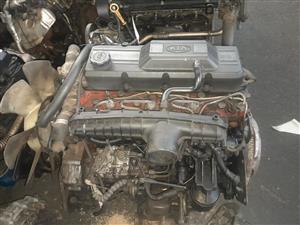Opel Corsa Engine: Performance and Integrity for Your Car
Opel Corsa Engine: Performance and Integrity for Your Car
Blog Article
Checking Out the Inner Workings of a Compact Lorry's Engine System
As chauffeurs, we usually take for given the detailed procedures that occur within the boundaries of our vehicle's engine system. In this expedition of a portable car's engine system, we will certainly unravel the internal functions of this mechanical harmony, shedding light on the secrets that drive us onward on our daily journeys.
Burning Refine Review
The combustion procedure in a compact automobile's engine system is a critical system that successfully transforms fuel into power to power the lorry. This process happens within the burning chamber of the engine, where gas and air mix, ignite, and generate controlled surges. The burning procedure includes 4 main phases: intake, compression, exhaust, and power.
During the consumption stage, the piston relocates downward, reeling in a mix of air and gas into the burning chamber. The next phase, compression, includes the piston relocating upward, pressing the air-fuel mix to raise its strength. Subsequently, in the power stage, the ignition system sparks the compressed combination, leading to a quick expansion of gases that requires the piston pull back. This down activity generates the power needed to drive the lorry. Lastly, in the exhaust phase, the burned gases are removed from the burning chamber through the exhaust valve, preparing the chamber for the following cycle. This cyclic burning process is fundamental to the procedure of a portable vehicle's engine system, making sure reliable energy conversion for propulsion.
Piston and Cyndrical Tube Interaction

The piston's exact fit within the cyndrical tube is crucial for maintaining optimal compression and preventing energy loss during burning. Tight clearances between the piston and cylinder walls ensure effective sealing, enabling the piston to relocate efficiently without permitting gases to leakage past. Appropriate lubrication is likewise crucial to minimize friction and wear in between these components, improving longevity and performance.
Moreover, the design and materials used in producing the piston and cyndrical tube influence engine effectiveness visit this page and sturdiness. Modern engines often use lightweight yet long lasting materials like aluminum alloys for pistons and cyndrical tube linings to lower inertia and improve thermal performance. On the whole, the unified interaction in between the piston and cylinder is basic to the engine's capability and general performance.
Gas Shot System Performance
Fuel shot systems in small vehicle engines play a critical function in exactly delivering gas to the combustion chamber for controlled and reliable ignition. The fuel shot system functions by infusing fuel into the burning chamber at the ideal moment throughout the engine's operation (opel corsa engine). This exact timing ensures that the fuel blends evenly with the air for appropriate combustion, causing enhanced fuel effectiveness and reduced discharges
There are primarily 2 kinds of fuel shot systems utilized in portable car engines: port gas injection (PFI) and direct gas injection (DFI) PFI systems infuse fuel right into the consumption port prior to the intake shutoff, while DFI systems infuse fuel straight right into the burning chamber. Both systems you can try here have their advantages, with DFI offering much better gas atomization and PFI providing a much more cost-effective option.
Recognizing Engine Cooling Devices
Efficient operation of a compact vehicle's engine counts greatly on the efficiency of its cooling mechanisms. The air conditioning system in a portable automobile normally is composed of a number of components functioning with each other to control the engine temperature. Recognizing these engine air conditioning mechanisms is essential for maintaining the performance and long life of a small car's engine system.

Exhaust System Parts Explained
The ideal functioning of a small automobile's engine cooling devices depends on a complementary system recognized as the exhaust system, which consists of different vital components for making sure efficient discharges and engine efficiency. The exhaust manifold collects exhaust gases from the engine's courses and cylinders them to the catalytic converter.
One critical component of the exhaust system is the oxygen sensing unit, which monitors the oxygen levels in the exhaust gases to assist manage fuel usage and ensure optimum engine performance. opel corsa engine. In addition, the resonator might be existing in some exhaust systems to reduce noise levels. On the whole, the exhaust system plays a vital duty in maintaining engine effectiveness, reducing damaging discharges, and making certain a quieter driving experience for compact car proprietors

Final Thought
Finally, the compact car's Go Here engine system is an intricate mix of components that collaborate to promote the burning procedure, transform fuel into power, and expel waste gases. Comprehending the internal operations of the engine system, including the piston and cylinder communication, fuel injection system, engine air conditioning devices, and exhaust system components, is important for keeping optimal performance and effectiveness of the automobile.
The combustion procedure in a portable lorry's engine system is a crucial system that effectively converts fuel into energy to power the car.Fuel shot systems in portable lorry engines play an essential duty in specifically providing gas to the burning chamber for controlled and reliable ignition.There are mostly 2 types of gas shot systems utilized in small car engines: port fuel injection (PFI) and direct gas injection (DFI) Understanding these engine cooling systems is crucial for preserving the performance and longevity of a compact lorry's engine system.
The ideal functioning of a compact lorry's engine air conditioning systems depends on a complementary system understood as the exhaust system, which makes up various essential parts for making certain effective emissions and engine efficiency.
Report this page